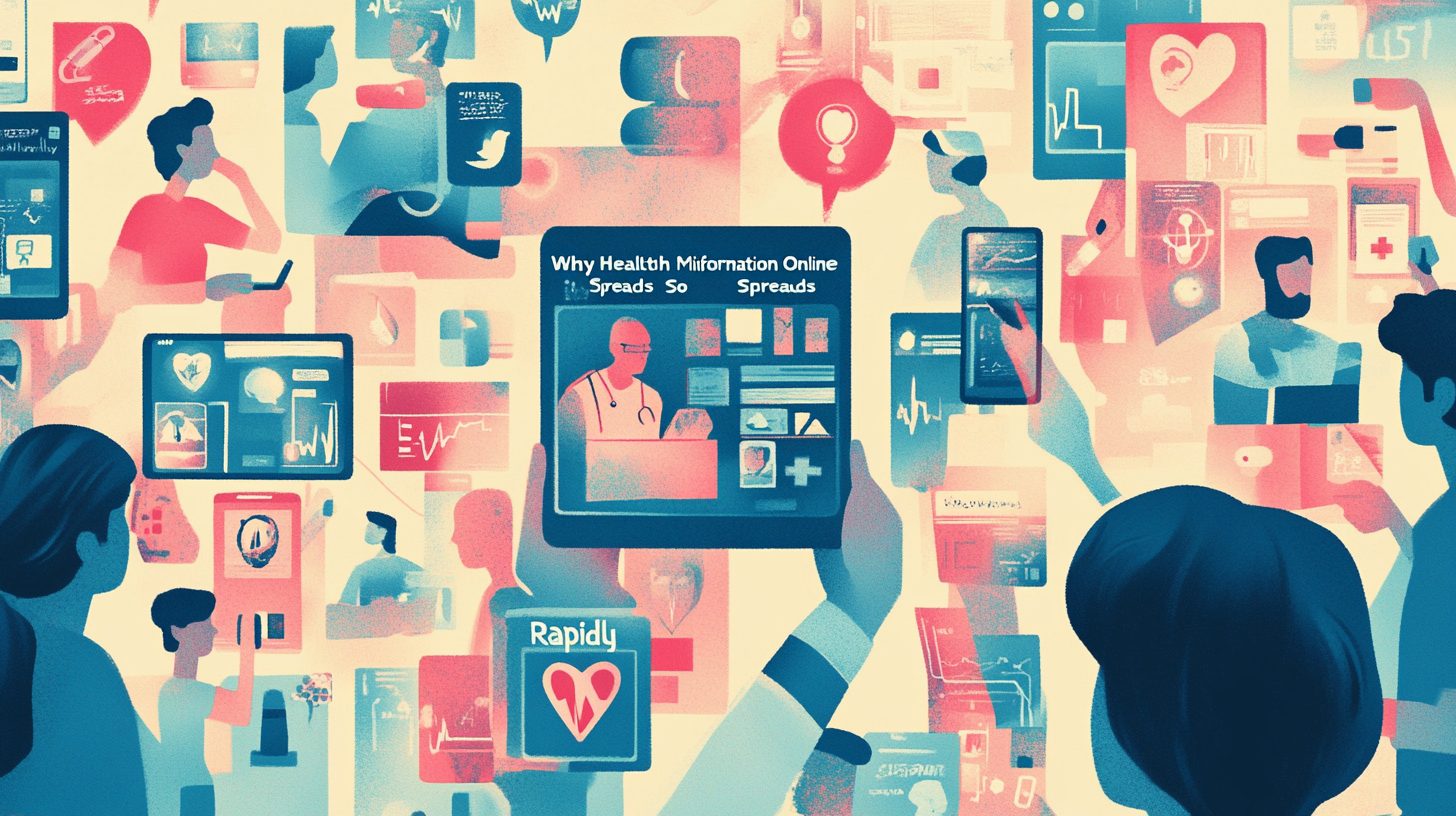In today’s digital landscape, health misinformation online travels at unprecedented speed. With nearly universal internet access, information—both accurate and inaccurate—is just a click away. According to a 2024 report by the International Panel on the Information Environment (IPIE), experts are particularly concerned about “the threats to the information environment posed by the owners of social media platforms.”
These platforms circulate countless health-related videos, articles, and posts daily. Without strict regulations governing shared content, much of what we encounter may be health misinformation online or even deliberate disinformation designed to mislead.
Understanding the Difference: Misinformation vs. Disinformation
When discussing health misinformation online, it’s important to distinguish between two related but distinct phenomena:
Misinformation occurs when communication contains inaccuracies due to misinterpretation, misunderstanding, or the inadvertent sharing of erroneous information.
Disinformation is more insidious—it involves the deliberate dissemination of false information by bad actors attempting to manipulate audiences to support hidden agendas.
Both can be equally harmful when it comes to health information, potentially leading people to make dangerous decisions about their wellbeing based on falsehoods.
Why We’re Vulnerable to Health Misinformation Online
To understand our susceptibility to health misinformation online, we need to explore what experts call “attitude roots”—the foundational beliefs and worldviews we’ve developed throughout our lives.
Dr. Dawn Holford, a behavioral science researcher at the University of Bristol who specializes in the psychology of communication, explains:
“Attitude roots are part of our psychology, and they can be beliefs, worldviews, emotions—basically, they are motivational drivers of how we process information.”
These roots can include emotions like anxiety about medical procedures or vaccination. When we encounter information that aligns with these pre-existing attitudes—even if it’s false—we’re more likely to accept it as true.
Research consistently shows humans are prone to confirmation bias—we selectively seek evidence that supports our existing beliefs. This tendency is so powerful that it can be extremely difficult to overcome, even when confronted with contradictory facts.
Who Is Most Susceptible to Health Misinformation Online?
While anyone can fall prey to health misinformation online, certain factors may increase susceptibility:
- Ideological alignment: People tend to believe information that matches their existing worldview
- Psychological traits: Lower “actively open-minded thinking” correlates with higher susceptibility
- Previous negative healthcare experiences: Experiences of discrimination or poor treatment can increase distrust in official sources
- Emotional resonance: Information that triggers strong emotional responses often bypasses critical thinking
As Dr. Holford notes, “Which group would be more susceptible depends on how misinformation is crafted to create alignment with people of that group’s beliefs.”
Why Some People Mistrust Official Health Sources
An important dimension of health misinformation online is understanding why some individuals distrust information from official health sources in the first place. This mistrust isn’t always irrational—it can stem from:
- Experiences of racism or discrimination in healthcare settings
- Gender bias affecting diagnosis and treatment
- Previous negative experiences with healthcare institutions
- Historical abuses by medical establishments against certain communities
These legitimate concerns can create fertile ground for misinformation that validates these negative experiences, even when the misinformation itself is harmful.
How to Verify Health Information Online: Expert Strategies
To combat health misinformation online, Dr. Holford and her colleagues have developed “jiu-jitsu interventions” that use misinformation’s own characteristics against it. Two key approaches include:
1. Psychological Inoculation Against Health Misinformation Online
Similar to how vaccines work, this approach exposes people to weakened forms of misinformation tactics so they can recognize them in the future. By understanding how misinformation manipulates through tactics like:
- Cherry-picking information
- Appealing to emotions
- Relying on fake experts
- Using misleading statistics
People can develop resistance to these deceptive techniques.
2. Empathetic Refutation of Misinformation
This approach acknowledges the underlying concerns that make someone susceptible to misinformation and addresses them with empathy rather than dismissal. It makes corrections feel less threatening and more acceptable.
Practical Tips for Spotting Health Misinformation Online
Dr. Holford recommends “lateral reading” to verify health information:
“If we encounter health information on one site or platform, we would look outside of that site or platform for other sources to determine the credibility of the first source, and whether what we have read is backed up by sources independent of the original source.”
This is especially important when we find information that perfectly aligns with what we want to hear—these moments of perfect alignment should trigger additional scrutiny, not immediate acceptance.
Other verification strategies include:
- Checking the author’s credentials and potential conflicts of interest
- Looking for citations of peer-reviewed research
- Verifying whether multiple reputable sources report similar information
- Being wary of sensationalist headlines or claims of “miracle cures”
- Checking publication dates to ensure information is current
Where to Find Trustworthy Health Information
Despite growing mistrust in some quarters, governmental public health organizations remain among the most reliable sources of health information. As Dr. Holford points out:
“Governmental public health organizations are often the places where the information is reliable—because they are accountable to citizens in a way that other content generators would not be. Many also make an effort to share information using accessible language.”
For those who feel unable to trust their local government sources, Dr. Holford suggests looking to global organizations:
- World Health Organization (WHO)
- Non-governmental health organizations with established reputations
- Patient advocacy groups with scientific advisory boards
- Academic medical centers and university health resources
In the UK, resources like Patient Info have gathered expert advice across a wide range of health topics.
The Role of Social Media in Spreading Health Misinformation Online
The prevalence of health misinformation online is closely tied to social media usage. According to a 2024 Healthline consumer survey, more than half of US respondents reported gathering health information via social media, and 32% relied on family, friends, and colleagues for health advice.
Interestingly, despite this heavy reliance, respondents also indicated they didn’t fully trust these sources’ accuracy—suggesting many people consume information they themselves suspect might be unreliable.
In the UK, a nationally representative survey by The Alan Turing Institute found that 94% of the population had witnessed misinformation circulating on social media.
The Responsibility of Health Information Providers
While individuals must develop skills to identify health misinformation online, Dr. Holford emphasizes that the responsibility shouldn’t fall solely on consumers:
“I strongly believe that the onus [to verify the accuracy of information] cannot only be on patients and consumers. Rather than accepting that it’s just up to us to work out what is true, we can advocate for better information quality control on platforms where people go to find health information.”
Health information providers, including news websites, have a duty to perform rigorous fact-checking before publishing content.
Consulting Healthcare Providers: The Gold Standard
For personalized guidance and fact-checking, Dr. Holford recommends consulting trusted healthcare providers:
“If you have a trusted health provider or community health representative whom you can talk to, it is really worth seeking them out to ask for advice on where to look. Being able to have that conversation, if you have access to that, is probably the best I could recommend.”
Healthcare professionals can provide context for general health information and help tailor it to individual circumstances.
Building Digital Health Literacy for the Future
As health misinformation online continues to evolve, building strong digital health literacy skills becomes increasingly important. These skills include:
- Understanding how health information is produced and distributed
- Recognizing common misleading tactics and logical fallacies
- Knowing how to verify information across multiple reliable sources
- Being aware of one’s own biases and emotional responses
- Developing comfort with scientific uncertainty and evolving knowledge
By strengthening these capabilities, individuals can better navigate the complex information landscape and make more informed health decisions.
Key Takeaways: Combating Health Misinformation Online
- Health misinformation online spreads rapidly through social media and can lead to harmful health decisions
- Understanding our psychological “attitude roots” helps explain why we’re vulnerable to misinformation
- “Lateral reading” across multiple credible sources is crucial for verification
- Governmental health organizations, WHO, and trusted healthcare providers remain reliable information sources
- Both individual skills and systemic changes are needed to address the misinformation challenge
- Approaching new information with appropriate skepticism, especially when it perfectly confirms existing beliefs
- Building digital health literacy is essential for navigating today’s complex information environment



